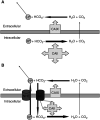Diagnostic, prognostic and therapeutic implications of carbonic anhydrases in cancer
- PMID: 12838292
- PMCID: PMC2394207
- DOI: 10.1038/sj.bjc.6600936
Diagnostic, prognostic and therapeutic implications of carbonic anhydrases in cancer
Abstract
The carbonic anhydrases (CAs) comprise a family of evolutionarily ancient enzymes found ubiquitously in nature. They have important roles in facilitating transport of carbon dioxide and protons in the intracellular space, across biological membranes and in the unstirred layers of the extracellular space. The tumour-associated isoenzymes, CAIX and CAXII, are expressed in a wide variety of malignancies and appear to be tightly regulated by microenvironmental hypoxia. CAIX expression is linked to poor prognosis in a number of human tumours, and may be a marker of aggressive malignant phenotype and a mechanism of progression. Inhibitors of CA may inhibit tumour growth and invasion, with consequent therapeutic potential.
Figures

References
-
- Beasley NJ, Wykoff CC, Watson PH, Leek R, Turley H, Gatter K, Pastorek J, Cox GJ, Ratcliffe P, Harris AL (2001) Carbonic anhydrase IX, an endogenous hypoxia marker, expression in head and neck squamous cell carcinoma and its relationship to hypoxia, necrosis, and microvessel density. Cancer Res 61: 5262–5267 - PubMed
-
- Chegwidden WR, Dodgson SJ, Spencer IM (2000) The roles of carbonic anhydrase in metabolism, cell growth and cancer in animals. Exs 343–363 - PubMed
-
- Dachs GU, Patterson AV, Firth JD, Ratcliffe PJ, Townsend KM, Stratford IJ, Harris AL (1997) Targeting gene expression to hypoxic tumor cells. Nat Med 3: 515–520 - PubMed
-
- Divgi CR, Bander NH, Scott AM, O'Donoghue JA, Sgouros G, Welt S, Finn RD, Morrissey F, Capitelli P, Williams JM, Deland D, Nakhre A, Oosterwijk E, Gulec S, Graham MC, Larson SM, Old LJ (1998) Phase I/II radioimmunotherapy trial with iodine-131-labeled monoclonal antibody G250 in metastatic renal cell carcinoma. Clin Cancer Res 4: 2729–2739 - PubMed
Publication types
MeSH terms
Substances
LinkOut - more resources
Full Text Sources
Other Literature Sources

